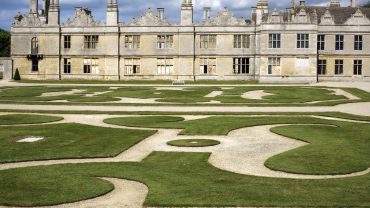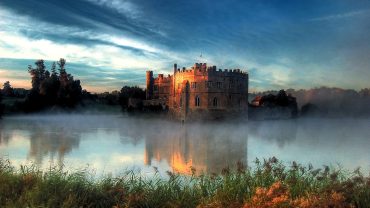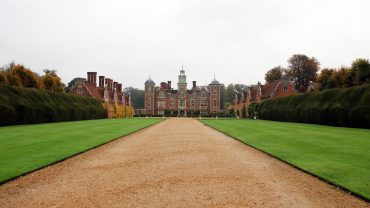Originating from the servant-run kitchens of England’s stately homes and the warm, communal farmhouses of rural counties, English country kitchen design has evolved over centuries to become the heart of modern homes. From medieval hearths in great halls to the functional sculleries of Georgian townhouses, English country kitchens reflect a rich heritage shaped by social norms, technological advancements, and culinary practices.
Today, they embody a blend of historical depth and contemporary functionality, offering a space that’s both practical and inviting. Are you ready to immerse yourself in the cosy comfort of an English cottage kitchen? Put the kettle on and let’s begin.
The Characteristics of English-Style Country Kitchens

A classic English country kitchen (Credit: Mint Images via Getty Images)
The classic English country kitchen draws inspiration from natural materials and rustic influences. Exposed wooden beams, brickwork, flagstone floors, and copper accents are all hallmarks of this style. Cabinetry often features painted finishes in earthy tones, paired with solid wood or polished granite countertops for durability. These elements – which make up a component part of the overall cottagecore aesthetic – combine to create a harmonious balance between old-world charm and modern convenience.
And it doesn’t matter if you live in a modern city centre apartment or an eighteenth century thatched cottage in the Oxfordshire countryside, the classic English country kitchen aesthetic is one that everyone can fall in love with! From hearth to heart, step inside the warmth of traditional English kitchen design.
The Essence of An English Cottage Kitchen

Warm colours and rustic elements of an English country kitchen (Credit: Andreas von Einsiedel via Getty Images)
The true essence of an English country kitchen lies in its careful balance of different design elements, each contributing to its unique charm and functionality. From the selection of materials to where you put accessories, every detail is thoughtfully considered to create a warm and inviting space that feels cosy, lived in and personal. Here, we’ll explore some of the key elements that define this beloved style, as well as a few tips and hints to inspire your own kitchen transformation.
Natural Materials
English country kitchens often embrace natural materials such as wood, stone, and brick. Examples include wide-plank hardwood floors, granite countertops, patinated metals, and exposed brick walls, all of which add warmth and authenticity to the space.
Warm Colours
These kitchens often feature warm, earthy tones such as terracotta, olive green, and mustard yellow. Soft hues like sage green, grey, and creamy white are also common, creating a cosy and inviting atmosphere
Rustic Charm
Rustic elements are key to English-style country kitchens, adding character and a sense of history. This might include exposed wooden beams, weathered finishes on cabinets, or vintage-inspired fixtures.
Mix of Textures
English country kitchens incorporate various textures to create visual interest. This could involve combining smooth granite countertops with rough-hewn or weathered wooden beams, or pairing glossy tiles with matte painted cabinets.
Freestanding Furniture
Antique dressers, farmhouse and refectory tables, shaker-style cabinets with panelled doors, butcher’s blocks, and freestanding islands are common in rural English kitchen design. These decorative pieces can add character and flexibility, as well as allowing for easy rearrangement.
Traditional Layout
A classic English cottage kitchen often features a traditional layout with a large central island or farmhouse table as the focal point. This encourages people to socialise while also providing ample workspace. Also consider the main centres of activity (sink, cooker, and fridge) forming a working triangle for ease of movement.
Decorative Details & Minimal Decoration
Subtle decorative elements such as carved woodwork, ornate hardware, or patterned tiles can add charm to English country kitchens. These details contribute to the overall rustic look without overwhelming the space. You can also add touches of personality, such as antique signs, or wall-mounted plates, or accessories like copper pots, vintage scales, or ceramic jugs. While English-style kitchens are warm and inviting, they tend to avoid excessive decoration. Their inherent beauty lies in the natural materials and simple, functional design.
Open Shelving
Open shelves are a staple of English kitchen design, providing both storage and display space. They’re often used to showcase collections of pottery, glassware, or cookbooks.
Farmhouse Sink
A deep, ceramic farmhouse sink is a quintessential feature of an English cottage kitchen. These sinks are both practical and aesthetically pleasing, adding to your space’s rustic charm.
Architectural Features
English country kitchens often highlight architectural elements such as exposed beams, wooden trusses, high ceilings, and large windows. These features add character and create a sense of spaciousness.
Ending on a High (Tea) Note

An English cottage-style kitchen (Credit: John Keeble via Getty Images)
The English country kitchen aesthetic is more than just a design style. It’s an expression of warmth, history, and personal taste. Whether you prefer vintage charm or a more modern interpretation, the key is to create a kitchen that reflects your unique character and caters to the demands of contemporary living, making it the true heart of your home.











